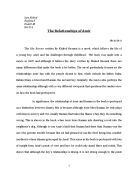From the start of the novel, Hosseini uses association, which links an emotionally charged person or entity to a separate entity to influence someone's opinion. In The Kite Runner, the reader's perception of Afghanistan is tied to the sympathetic character of Hassan, the narrator's friend and half-brother. A stereotype exists in America that all Middle Easterners are violent; however Hosseini associates Afghanistan with a boy who is lamb-like in nature. The narrator, Amir, states that "...to me, the face of Afghanistan is that of a boy...with a Chinese doll face perpetually lit by a hare-lipped smile" (25). He is of course referring to Hassan, who was born with a harelip. Amir connects Hassan with his image of Afghanistan throughout the novel, creating an emotional tie for the reader as well. Hassan is the epitome of goodness and self-sacrifice, who allows himself to be brutalized so that Amir can bring home a trophy to his father. Hassan seems to have no faults, and Amir acknowledges that he is one of those "people who mean every word they say" (54). Hosseini truly makes one feel for Hassan, and in turn, for Afghanistan.
Another way in which The Kite Runner influences opinions about Afghanistan is by demonizing the enemy; in this case the Taliban. Many Americans falsely believe that all Muslims are as strict in their religion as the Taliban. However, Hosseini makes a clear distinction between the average Afghan and their extremist rulers, and emphasizes their brutality in contrast with the more prevalent, more liberal Muslim practices in Afghanistan. He does this by creating an image of the Taliban that is almost evil in nature. Assef, the face of the Taliban in the novel, is a bloodthirsty sociopath. Amir recalls that, "I will never forget how Assef's blue eyes glinted with a light not entirely sane" (38). Assef is also the one who rapes Hassan, the kind, sensitive boy who is associated with Afghanistan as a whole. This is an allegory for what the Taliban did to Afghanistan in reality; along with oppressing its citizens, they led to the flourishing of the opium trade instead of the growth of more useful, edible crops. Hosseini also uses the other Afghan's characters’ responses to the Taliban to reveal the gap between them and the average Afghan. Amir's mentor, Rahim Khan says, "They don't let you be human" (198). This portrayal of the Taliban is blatantly unilateral and damns all of its members. Demonizing the Taliban in this way causes one to dissociate them from the rest of the Afghans in the novel who are portrayed in a more positive light.
At the same time, Hosseini uses the technique of appealing to the "common man" to compel aid in the identification of Americans with Afghan culture. There is a tendency in this country, separated as it is by much of the world buy an ocean or two, to label foreigners as "strange" and regard them as inherently different. In The Kite Runner, Afghan characters are shown doing many of the common everyday things that Americans do: going to see a movie, playing in the streets, and gossiping in the market. It's these small details Hosseini includes that make the Afghans seem human and accessible to the reader. Amir fondly relates how the Afghans would socialize at the flea market. He recalls, "Tea, Politics, and Scandal, the ingredients of an Afghan Sunday at the flea market" (138). Substitute coffee for tea, and I'm sure many Americans would find a striking similarity in the same experiences of socializing with friends and discussing the latest news. The Kite Runner turns Afghans from "the other" into human beings to whom Americans can relate.
Throughout his novel, Khaled Hosseini uses potent psychological techniques a tool to influence opinions about Afghanistan and the people who live there. His portrayal of Afghanistan is mixed at times, yet it takes steps to positively break down stereotypes that pervade American beliefs about Muslims and the Middle East. It is far from offering a solution to race conflicts, but if everyone read it, perhaps there would be more positive dialogue between Americans who are of Afghan origin, and those who are not. And that would be a good thing.








